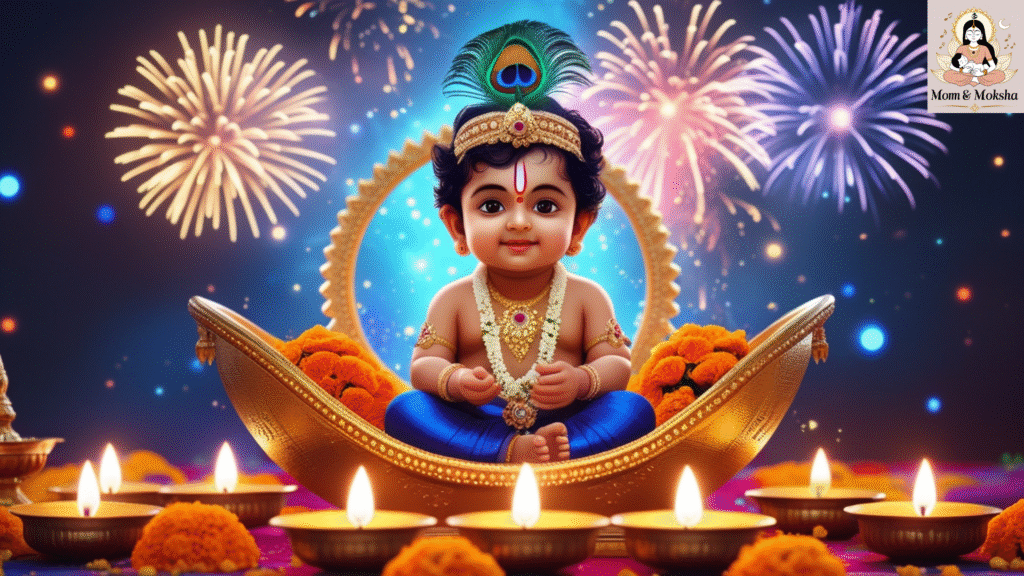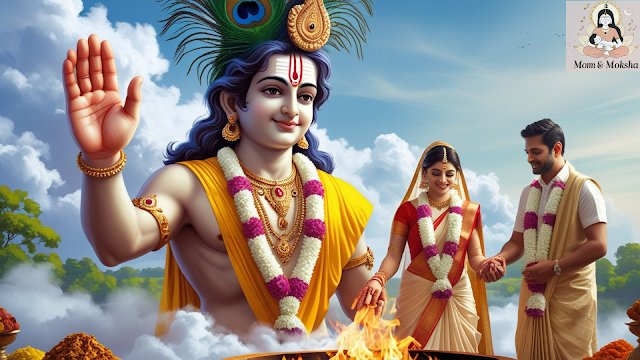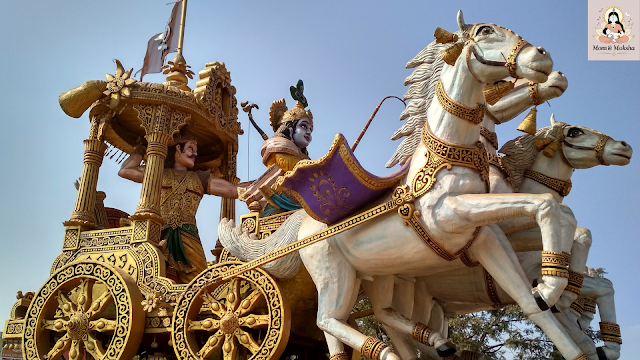A Story of Midnight Laughter and Divine Light
Imagine a midnight when the sky itself grows gentle — stars bow, rivers gleam, and the whole earth inhales in joy. That is how the Puranas describe the night of Kṛṣṇa’s janma (birth): not an ordinary human birth but the Lord’s re-appearance to restore dharma. The Bhagavata (Śrīmad-Bhāgavata-Purāṇa) and the Vishnu Purāṇa both narrate the event richly — a story of prophecy, imprisonment, a tyrant king (Kamsa), and the miraculous transfer of the newborn from Mathurā to Gokula. For devotees this is Janmashtami — a night of vigil, bhajans, and midnight pūjā.
Scriptural Accounts: Bhagavata Purana & Vishnu Purana
Bhagavata Purana — The Classical Narrative (Canto 10, Chapter 3)
Śrīmad-Bhāgavatam gives the most detailed, devotional portrait of Krishna’s appearance. It opens Chapter 3 with a cosmic scene: nature smiles, celestial beings shower flowers, and saints rejoice. The text explicitly frames Krishna’s birth as svayaṁ-līlā — the Lord’s own joyful manifestation. Key verses (Canto 10.3) describe Devakī’s womb, the divine migration, and the midnight arrival in Vrajā (Gokula). Authoritative online editions and commentaries (Vedabase / Śrīmad-Bhāgavatam translations) provide word-for-word verses and purports for deeper study.
On that midnight of Bhadrapada Krishna Ashtami, time itself stood still. The Bhagavata Purana says:
atha sarva-guṇopetaḥ kālaḥ parama-śobhanaḥ — “Then arrived the all-auspicious moment, endowed with every virtue.”
Across the heavens, devas showered flowers, rivers flowed in melody, and imprisoned Devakī beheld not an ordinary infant, but Nārāyaṇa Himself. This is the moment we call Janmashtami.
Why this matters: The Bhāgavata frames Krishna’s birth as a cosmic event — not merely a historical birth but a theophany. That affects how Janmashtami rituals emphasise vigil (jāgaraṇa), kīrtan, and midnight pūjā.
Just as the Bhagavad Gita’s different Adhyayas offer guidance for every life challenge — from fear to confusion — the birth of Krishna itself was a divine response to the suffering of the world.
(Read: Which Chapter of the Bhagavad Gita Solves What? A Practical Guide for Modern Life)
The Bhagavata Purana’s Account (Śrīmad-Bhāgavatam 10.3)
The Bhagavata Purana offers the most heartfelt and detailed description of Krishna’s divine appearance. Here are some key verses:
SB 10.3.8
Sanskrit:
ततो जगन्मङ्गलमच्युतांशं
समाहितान्तःकरणा दिदृक्षुः ।
तमादिदेवं पुरुहूतपुज्यं
शान्तं स्तुवन्निष्टतमाहुः ॥
Transliteration:
tato jagan-maṅgalam acyutāṁśaṁ
samāhitāntaḥ-karaṇā didṛkṣuḥ
tam ādi-devaṁ puruhūta-pujyaṁ
śāntaṁ stuvan niṣṭhatam āhuḥ
Translation:
Then, eager to behold the Supreme Person, the origin of the universe’s auspiciousness, whose portion is Acyuta Himself, the hearts of the pure became absorbed. They praised Him — the original Lord, worshiped by Indra, peaceful and most steadfast.
SB 10.3.9–10
Sanskrit:
निशीथे तमउद्भूते जायमाने जनार्दने ।
देवकीं देवदेवस्य वपुः प्रादुरभूत्प्रभुः ॥
तदा सर्वगुणोपेतः काले परमहंस्यपि ।
जातः कंसवधोद्युक्तः कृष्णः कमललोचनः ॥
Transliteration:
niśīthe tam udabhūte jāyamāne janārdane
devakīṁ deva-devasya vapur prādur abhūt prabhuḥ
tadā sarva-guṇopetaḥ kāle paramahaṁsy api
jātaḥ kaṁsa-vadhodyuktaḥ kṛṣṇaḥ kamala-locanaḥ
Translation:
At midnight, when the darkness was deep, Janārdana appeared. In Devakī’s heart, the form of the Lord of lords manifested. At that supreme moment, adorned with every virtue, Krishna — the lotus-eyed — took birth, ready to end the tyranny of Kamsa.
SB 10.3.12
Sanskrit:
श्रीशुक उवाच —
तं अद्भुतं बालकमम्बुजेक्षणं
चतुर्भुजं शङ्खगदाद्युदायुधम् ।
श्रीवत्सलक्ष्मं गलशोभिकौस्तुभं
पीताम्बरं सन्ध्रपयोधसौरभम् ॥
Transliteration:
śrī-śuka uvāca —
taṁ adbhutaṁ bālakam ambuje-kṣaṇaṁ
catur-bhujaṁ śaṅkha-gadādy-udāyudham
śrīvatsa-lakṣmaṁ gala-śobhikau-stubhaṁ
pītāmbaram sandhra-payodhasaurabham
Translation:
Śukadeva Gosvāmī said: That wondrous child, with lotus-like eyes, appeared with four arms, bearing the conch, mace, and other weapons. He was marked with the Śrīvatsa, adorned with the Kaustubha jewel upon His neck, clothed in yellow garments, and exuding the fragrance of a rain-filled cloud.
Vishnu Purana — the Historical-Mythic Record
The Vishnu Purāṇa (Book/Vamsa sections) also recounts Krishna’s birth, childhood pranks, and the slaying of Kamsa, offering a narrative focused on cosmic dharma and genealogy.Born to rid the world of adharma, Krishna’s arrival was foretold by sages and devas alike. The text describes how Vasudeva carried the newborn across the Yamuna to Gokula, where Yashodā and Nanda unknowingly became His foster parents.
The way Devaki and Vasudeva surrendered to divine will reflects timeless parental wisdom.
(Read: Bhagavad Gita Shlokas Every Parent Should Know)
Krishna Janmashtami 2025 — Date & Timing
In 2025 the lunar tithi (Bhadrapada Krishna-paksha Ashtami) falls across August 15–16, 2025 in many panchāngas; most mainstream sources list August 16, 2025 as the principal observance (with the main nishta/ñishitha pūjā reaching its peak at midnight). Because tithi boundaries vary by locality, many devotees begin vrata and night-long bhajans late on August 15 and perform the midnight ritual on August 16. (Check your local panchānga / temple for exact nishta times).
2025 Janmashtami Pūjā Steps
Essentials to prepare: clean altar; a small cradle (vāhana) or covered platform for Laddoo-Gopal (infant Krishna), flowers, sandal paste, incense, ghee lamp, bilva/tilak, banana/dry fruits, butter/milk sweets (makhan/khoya laddoos), and bhajan ślokas/book.
Suggested sequence (adapted from traditional panchānga guidelines & temple practice):
- Shodashopachara (16-fold offering: āvāhanam, dhyāna, etc.) in simplified home form — āvāhanam (invocation), dhyāna (meditation on form), ācamanam (water), snāna (symbolic bathing of the idol with panchamrita), vastra (dress), abharaṇa (ornaments), pushpa/ākāśa (flowers), dīpa (lamp), naivedya (prasāda), arti. (Temple manuals / Janmashtami guides).
- Nishita Pūjā (midnight worship): awaken at the auspicious nishta (midnight when Ashtami tithi is prevailing), recite SB 10.3 slokas or play kīrtans, perform abhishekam (symbolic bath with milk-yogurt-ghee-honey), dress the infant form, offer sweets and sing “janma aagaya…”. Many temples conduct a special arati and distribution of mahaprasad.
- Vrat & Bhajan: observe fast (nirahara or phalahara), sing bhajans through the night, and in the morning perform visarjana (thanksgiving) with distribution of prasād.
Note: Exact muhurta (precise minute) for abhihseka/nishta varies by location — consult local panchānga or your temple for the correct nishta time on Aug 15–16, 2025.
Cultural Practices Across India (what people actually do)
Mathura & Vrindavan: grand night vigils, rāsa and mela processions, dramatic re-enactments (Raas Leela), temple abhishekam at midnight.
Maharashtra (Mumbai): Dahi Handi — human pyramid formations to break an earthen pot of curd, symbolising Krishna’s love of butter and playful raids.
South India & Bengal: devotional kīrtan, balakṛṣṇa decorations, local sweets (payaasam/khoya laddoo), community feeding (bhandara).
Conclusion — A Night that Still Happens Every Year
Every Janmashtami is not just a commemoration — it is a re-living.
When we light the diyas, sing Krishna’s names, and sway the cradle at midnight, we step into that eternal moment described in the Puranas. The same divine smile that lit up the prison cell of Mathura glows again in our homes and hearts.
In the stillness of that sacred hour, we realise — Krishna’s birth is not just history; it is the soul’s awakening to joy, love, and dharma. And for that, every year, the universe pauses… waiting for the sound of the flute to begin again.
Listen & Meditate
🎶 Experience the Divine Peace of Krishna’s Flute
As you reflect on the sacred night of Krishna’s birth, immerse yourself in the serene sound of His flute. This Krishna flute music is perfect for:
- Deep meditation after Janmashtami puja
- Creating a calming spiritual atmosphere at home
- Helping babies and adults drift into peaceful sleep
- Enhancing your yoga or pranayama practice
🌼 Close your eyes, imagine the moonlit night of Krishna’s birth, and let the flute carry your soul to Vrindavan.
The most detailed account is found in the Bhagavata Purana (10th Canto), while the Vishnu Purana and other texts also narrate Krishna’s appearance in Mathura at midnight.
Fasting on Janmashtami purifies the body and mind. It is believed that observing a vrat (fast) on this day brings blessings, removes obstacles, and deepens one’s devotion to Krishna.
Devotees usually eat sattvic foods like makhana, fruits, milk, butter, curd, nuts, and sabudana dishes. Grains, onion, and garlic are avoided.
Children and elderly are usually encouraged to observe light fasting or devotional offerings rather than strict fasts. The essence is devotion, not hardship.



